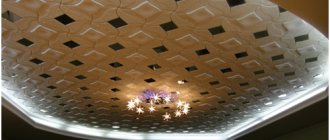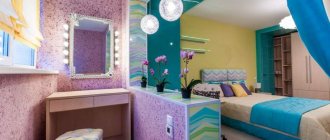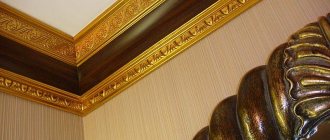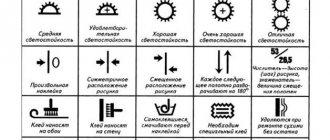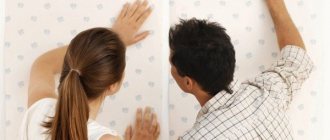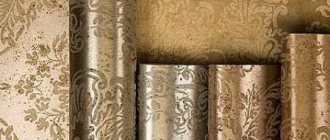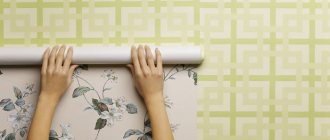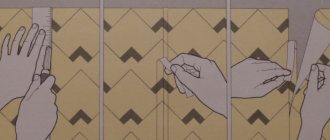Any material wears out over time, be it the finishing or the wall of a building. At the same time, its user qualities - the level of thermal insulation, strength - may remain the same, but the appearance deteriorates significantly.
How to glue wallpaper to lining?
The appearance of the finish can be restored using various methods.
How to put wallpaper on lining?
Choosing the right wallpaper
Buy thick wallpaper. Your local hardware store probably sells products made specifically for this purpose. For example, non-woven wallpaper is much denser than regular wallpaper and has a textured surface that can be used to hide panel seams. They can also be impregnated with special glue. They fit perfectly on a wooden surface in a log house.
Cleaning panels before repair
Now you need to thoroughly clean the wood panels. Cobwebs and dust are removed with a slightly damp, but not damp, sponge. Do not use cleaning products containing wax, oil or polish. If some panel elements are peeling off, they should be removed and sanded.
Continue preparing the panels for gluing. Carefully remove the skirting boards so that they can be put back in place after wallpapering. Ventilation grilles and electrical outlets should be removed. Some people prefer to smooth out the panel seams with putty, but this is not at all necessary if you have purchased suitable wallpaper.
Now you need to coat the panels with primer. It can be bought at any hardware store at a low price.
Wallpapering begins from the outer corners. Take the time to check if the angle is right. You can use a regular level for this. Measure the height of the wall. The first wallpaper can be cut a little longer than necessary. Then its length can be adjusted.
First, lightly moisten the wallpaper with glue so that it is slightly saturated. Glue should not drip from the brush or roller. There are special containers and trays that provide optimal collection of glue. You can apply glue to some types of wallpaper using a spray bottle or a damp sponge. They begin to glue the wallpaper from the ceiling to the floor.
It is always necessary to smooth the wallpaper using a dry brush, towel or rag, which will prevent the formation of bulges and bubbles. Bubbles are driven from the center to the edge with careful movements so as not to damage the canvas. In the same spirit, it is worth gluing the remaining strips, aligning them with the first one. If at the junction of the corners it is not possible to fit the wallpaper to a straight line, you can overlap it. This is much better than leaving a crack or sealing it with pieces of leftover scraps.
Follow the pattern
If the wallpaper has a symmetrical pattern, then when cutting subsequent panels you need to make sure that it matches. Most likely, you will have to cut off excess pieces of wallpaper in order to fold the pattern as expected.
Be sure to cut the holes for the rosettes while the wallpaper is still damp. Gluing should be done indoors without access to fresh air. Leave the wallpaper for a couple of days until it is completely dry, making sure that the corners or joints do not peel off. Reinstall the baseboards.
Gluing wallpaper onto wooden panelsThe article provides instructions for gluing wallpaper onto wooden panels yourself
Ceiling lighting
A competent choice of lighting allows you to give the room a unique individual style and create a harmonious atmosphere in it.
- LED Strip Light. Due to reflection from the ceiling surface, it creates a very soft and uniform level of lighting.
- Chandelier. The chandelier located in the center of the ceiling is a continuation of the style of the room and perfectly complements and supports its concept.
- Spotlights. A convenient option that allows you to illuminate the entire perimeter of the room or highlight only certain areas.
- With backlight. Designs with built-in lighting allow you to realize the most unusual design ideas and create a beautiful play of light on the ceiling.
Is it possible to glue wallpaper to lining?
Wallpapering with your own hands.
More than two decades ago, civilization finally reached us. There are practically no apartments left in which old wooden frames are installed and floors are laid.
We suggest you familiarize yourself with Where ladybugs live in nature
Natural wallpapers are actually very diverse, but are also created on a paper basis. Their gluing differs from paper, mainly due to their careful handling. They should only be cut with sharp scissors, never with a knife. You can’t bend natural wallpaper either.
Finishing a house made of aerated concrete with plasterboard.
Today, one of the most popular materials, which is most often used for the construction of private houses, is aerated concrete. These are the last houses to be built.
This method makes it impossible to fully insulate the room. To achieve a certain thermal insulation, you can paint the slabs with vapor-permeable paint made specifically for aerated concrete.
How to decorate the walls on the loggia: useful tips.
The correct design of the loggia allows you to create a beautiful corner for a pleasant pastime. For this purpose, it is necessary to choose the best option.
Foamed polyethylene covered with foil is also very convenient for use in residential areas. This is an environmentally friendly material, lightweight and with very high thermal insulation. Don't forget about polystyrene foam. It has been traditionally used in our country for several decades. The main advantage of such insulation will be its affordable price, and there is only one disadvantage - fragility and relative fragility.
How to glue wallpaper on drywall: methods and recommendations.
Drywall is used for a variety of purposes - leveling walls, producing a wide variety of structures. This material itself.
- in the corners of the room, the sheet should be glued directly from the corner itself, and then straightened onto the walls. This way you can achieve excellent adhesion at the corner.
Drywall in a frame house is a real plus.
The use of plasterboard in a frame house is possible inside and outside. To carry out the work, calculate the price and study the installation instructions.
Use moisture-resistant GVLV. It is laid in two layers. This ensures the rigidity and integrity of the structure. One of the advantages of working with drywall is that it can “get along” with any type of cladding.
How to attach lining to drywall: the right way.
The modern construction market today is filled with a lot of materials that are perfect for different types of work. And here it is far from it.
- Fir, poplar, linden - 450 kg/mm.
- Alder, pine - 500 kg/mm.
- Birch, elm - 600 kg/mm.
- Oak, hornbeam, ash - 700 kg/mm.
Is it possible to glue drywall to polyurethane foam?
- Before attaching drywall to the wall with glue, treat the surface with a primer. The choice of primer depends on the type of wall: if the material does not absorb moisture, then Betokontakt is the best choice; if it does, then we prime with Tiefengrund or similar in properties.
How to glue wallpaper on drywall to the wall and ceiling.
Many modern rooms are lined with plasterboard, so the question often arises of what to use to decorate it? The most popular.
As mentioned above, without careful preparation it will be impossible to correctly and efficiently stick wallpaper on drywall, even if, without following the rules, the result turned out to be quite good - it will not last long and will very likely entail additional costs.
Wallpapering on drywall and preparation for it.
Wallpaper is the most common material for decorating rooms. With their help, you can transform an ordinary room and make it modern and cozy.
- Select the appropriate glue for each type of wallpaper and dilute it in strict accordance with the instructions on the package.
- When wallpapering a gypsum board wall, you should start from the window.
- Glue should be applied not only to the strips of wallpaper, but also to the wall itself.
- You need to do the work in a room with a closed window so that the wallpaper does not come off the wall.
- It is important that the seams on the plasterboard sheets do not coincide with the joints of the wallpaper.
- It is better to smooth the pasted wallpaper with a rubber roller or a plastic spatula.
- In order for the wallpaper to dry well, the room in which it was hung must be tightly closed for a day.
We invite you to familiarize yourself with the TOP 310 ideas of what to give your grandmother for the New Year
Colors
Manufacturers of lining keep up with the times and offer a variety of shades of materials, so anyone, even the most sophisticated connoisseur, will find a color to their liking. Nevertheless, the choice of color must be approached carefully so that the future interior is fully consistent in the chosen style.
When giving preference to the golden-honey shade of natural wood, take into account the fact that excessive use of this color makes the interior heavier and makes the room look like a sauna. To avoid this undesirable effect, and at the same time make the atmosphere of the room warm and conducive to relaxation, add any contrasting colors to the decor - blue, green, burgundy, cream. And it is also recommended to use a matte finish. It meets fashion trends and gives the interior a sophisticated look.
Chocolate shades of the lining look great in the interior as bright touches. All light colors go well with these colors. To prevent the decoration of the room from becoming overloaded stylistically, add dark boards to only one of the walls, and support the selected shade of wood with accessories.
The currently fashionable trend of painting all clapboard walls white necessarily presupposes the presence of clearly consistent color elements in the interior. To prevent the room from turning out cold and uncomfortable, add details and furniture in burgundy, pistachio, terracotta and other calm colors.
The use of several tones of paint of the same color scheme in combination with natural wood looks quite organic. For example, the blue and white color of the ceiling and walls, supported by two colors of wood, will create an unusually pleasant environment for a children's room.
Pasting wallpaper onto PVC trim
A prerequisite for such gluing is the preliminary preparation of the working surface. Therefore, answering the question of whether it is possible to glue wallpaper on PVC plastic panels, we should say: yes, it is possible. However, it is necessary to remember that certain conditions must be met. So, what tools will you need and what is the sequence of your actions? Let's get a look:
- Prepare a primer for plastic and vinyl surfaces, a solvent or its equivalent, fine-grain sandpaper or its equivalent.
- First of all, treat the glossy surface, making it matte so that the wallpaper can stick to it, and wipe off all the fine dust.
- If possible, wipe the surface of the plastic with a slightly damp cloth and wait until it dries. It does not take a lot of time.
- Then you need to apply a primer designed for working with PVC and similar plastic-based materials.
- The next stage of work: surface treatment using a special adhesive primer diluted with white spirit. This is done using appropriate tools.
- After this, you can start gluing yourself and no longer worry about the question of whether it is possible to hang wallpaper on PVC plastic panels. The answer is of course positive: yes, it is possible!
Wallpapering
The technology itself is no different from conventional technology. The difference is the preparatory process.
- The surface is cleaned of dust and dirt. The seams should be cleaned especially carefully. If the material was coated with varnish or wax, the top layer will have to be removed. To do this, the lamellas are cleaned with sandpaper.
- Plastic slats are simply wiped with a damp sponge.
- It is recommended to putty the seams between the slats. This ensures at least relative durability of the finish.
- Both wooden and plastic surfaces are primed in several layers. Typically an acrylic latex primer is used.
- Then they begin gluing in the usual manner: apply a layer of glue, start working from the corner from the window, and so on. The photo shows a working moment.
Application of liquid wallpaper
This material is a cross between plaster and wallpaper. The similarity with the first is ensured by the method of application, with the second - a higher decorative effect due to the addition of various components: silk fibers, metal threads, mica and others.
The idea of covering the paneling with liquid wallpaper turns out to be even worse. The material really resembles plaster and fills small gaps, cracks and chips, as it is quite voluminous. It can fill the seams between the lamellas, but the material consumption will increase sharply, and this kind of finishing will cost more than dismantling the lining and preparing the base surface.
The seams between the lamellas can be filled with regular plaster. Then the total cost will not be so high.
The surface of the lamellas must be sanded and treated with a primer that increases adhesion. How to hang wallpaper on lining is covered in detail in the video.
Finishing touches
Be sure to cut the holes for the rosettes while the wallpaper is still damp. Gluing should be done indoors without access to fresh air. Leave the wallpaper for a couple of days until it is completely dry, making sure that the corners or joints do not peel off. Reinstall the baseboards.
The boring look of old lining can be decorated with wallpaper
Tired of the look of wood paneling on your walls? Then update the interior with wallpaper, this will allow you to avoid major expensive repairs to completely replace the interior decoration. I propose to understand in more detail how to do this correctly.
Combinations of different types of coatings
Decorative stone and wallpaper
As a rule, decorative stone is used in the interior to decorate an accent wall, so it is important to correctly combine different types of coatings. Tips for combining wallpaper and stone:
Tips for combining wallpaper and stone:
- a decorative stone at the bottom of the wall will visually elongate the space;
- horizontal or vertical stone panels are not recommended to be combined with patterns and ornaments;
- To create accents, you can decorate doorways or ledges to look like stone.
Look at the photo for combined wallpaper with decorative stone in the interior.
A combination of lining and wallpaper in the interior. interior decoration of the house with clapboard
Due to the fact that lining in its qualities and appearance closely matches the material of the walls, it is considered the most popular method of interior finishing of a wooden building. There are three types of lining:
- A sanded board that does not have a recess or cutout is called ordinary lining. Fastening is done using nails or self-tapping screws. It is characterized by low cost and low quality. The boards do not interlock, so the result may be warping. Due to its small thickness, chips may form on this coating.
- A board with smooth surfaces, connected with a tongue-and-groove lock, is a universal carriage board. It is more applicable due to its attractive appearance, simplicity and reliability of installation.
- Block House is a board with an ideal surface, the main purpose of which is to imitate natural rounded logs. The combination of parts of the structure is carried out using a tongue-and-groove locking connection. Fastening is carried out according to the principle used for universal carriage boards. Used for interior decoration, it creates a beautiful appearance and adds brightness and richness to the space.
Carriage board, like any wood, must be treated with antiseptic and other special compounds that increase its performance characteristics.
Advantages of covering walls with clapboard:
- Primitive coating and attractive appearance.
- The ability to hide flaws and hide communications under cover.
- Additional insulation of the house.
- Ease of installation work.
Flaws:
- Low fire resistance, like any other wood material, requires special processing.
- The high cost of the whole process, which is the price of the bars and antiseptic.
As practice shows, the lining has a stunning natural look and maintains the unique atmosphere created by the timber. But the high cost of work and materials reduces the capabilities and use of this material.
We invite you to familiarize yourself with Preparing roses for wintering: covering roses for the winter
What glue is suitable
Important characteristics of the glue are compatibility with the type of wallpaper and wooden surface. The main recommendations are given in the table:
| View | Characteristics |
| Universal PVA | Recommended for paper and light vinyl wallpaper. Does not contain harmful substances. Provides reliable adhesion of materials. not afraid of moisture and temperature changes. |
| Vinyl | Designed for vinyl wallpaper. Has good penetrating ability. |
| Non-woven | Designed for non-woven wallpaper. Contains bactericidal and antifungal substances. |
| Dispersed | Designed for glass wallpaper, so it can withstand the heaviest and densest materials. |
The glue brands of the following manufacturers have reliably proven themselves:
- Kleo;
- Quelyd;
- Methylane.
